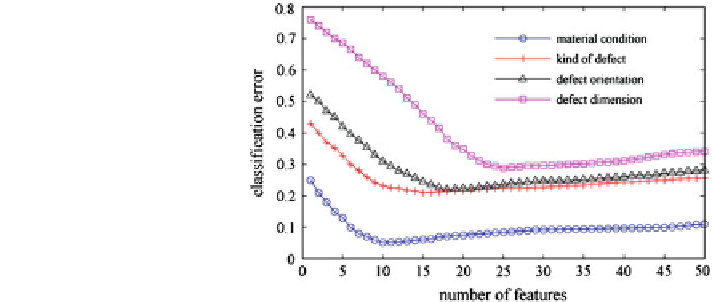Information Technology Reference
In-Depth Information
Fig. 5.7 Results of the
feature selection stage using
LDA classification
1...K to estimate the source densities. The parameters applied in the classifica-
tions by Mixca were the following: the kernel parameters were normalization
constant a=1; and the constant for defining the degree of smoothing was estimated
as h
¼
1
:
06rN
1
=
5
, which is the normal reference rule using a Gaussian kernel
[
28
]. The learning parameter a of the gradient technique used in Mixca was
selected in a rather experimental manner (a = 5e-05). However, some guidance
may help in reducing the search for a based on known conclusions about the
learning of ICA algorithms [
29
]. With regard to ICAMM, a discussion is included
in [
20
] which may help to understand the problems of convergence. The likelihood
threshold to stop the iterations was 1e-05.
5.3.3 Patterns Detected in ICA Mixtures
Figure
5.8
shows the spectra extracted from the 100 simulated models at channels
a2 and a3 of Fig.
5.3
. In the vertical axes, the lower position spectra correspond to
homogeneous pieces, and the higher position spectra correspond to multiple-defect
pieces. The wave propagation phenomena (depending on the defects) produce
frequency shifting, appearance of new tones, and also enlargement of the tones,
which can all be clearly observed. In addition, these phenomena are different for
different models. It was assumed for the proposed classification that the shifting
spectra depend more on the orientation (X or Y axes, and XY, ZY, or XZ planes)
and the dimension (passing or not passing through defect) of the defects than on
the defect location.
Figure
5.9
shows a scatterplot for the compressed mass spectra of the multi-
channel impact-echo setup from the experiments in the kind of defect level
(4 classes), The data are drawn in a 3D space defined for the first three spectra
features of the data set vectors. Figure
5.9
has been rotated to highlight a point of
view where the data for the different classes are discernible; however, there are
zones where the data are packed together, which make the separation of samples

Search WWH ::

Custom Search